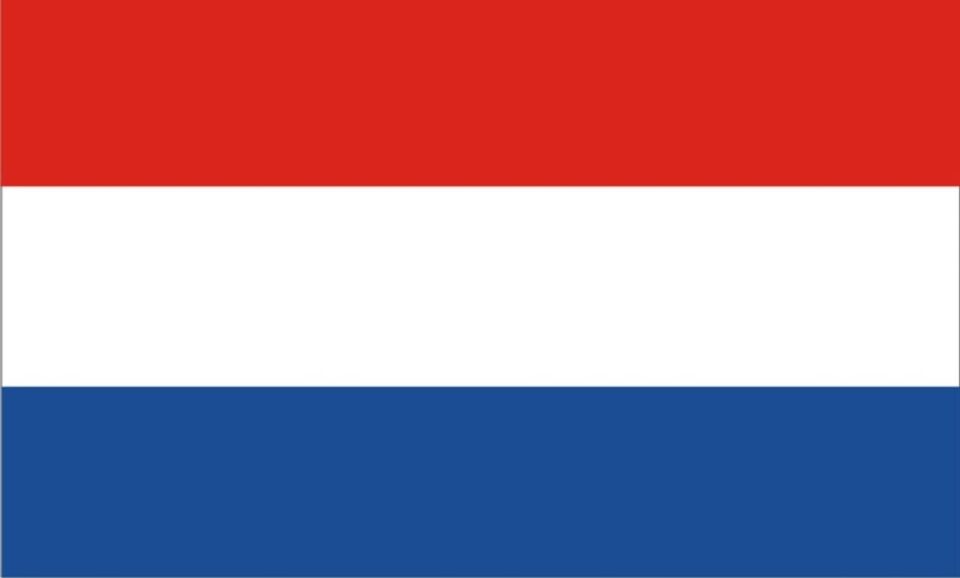
THE NETHERLANDS
GEOGRAPHY
The Netherlands borders on the north and west by the North Sea, on the south by Belgium and on the east by Germany. Hollande is a very flat country with almost 25% of its land at or below sea level. Low rolling hills cover some of the central area, and in the far south, the land rises into the foothills of the Ardennes Mountains. Over many centuries severe floods devastated the Netherlands, killing tens of thousands. So, the Dutch used countless windmills to pump water out of low-lying areas. They constructed man made hills raising the level of farms and villages. In 1953, extremely high water caused nearly 2,000 deaths, and so began the Delta Project. The plan was to construct a large series of outer sea dikes, and inner canal and river dikes to protect this fragile land from the constant pressures by the North Sea. Today nearly 50% of the land here remains just above sea level. The Netherlands is crossed by hundreds of miles of navigable canals, one of the most important is the North Sea Canal, as it enables ocean-going ships to reach the port of Amsterdam.
HISTORY
Until the nineteenth century, Holland was a region of the delta divided into several provinces, each of them with its own administration. On March 29, 1814 the country became the United Kingdom of the Netherlands led by the Orange-Nassau family.
THE MONARCHY
During the Middle Ages, Holland was divided into counties and duchies. Only in 1750 William IV Orange-Nassau was proclaimed a hereditary statolder affirming the power of the Orange. Since 1814, Holland has been a constitutional monarchy; the king represents the head of state who together with the minister forms the government. On March 16, 1815, William I proclaimed himself king of the Netherlands and attempted to protect the interests of his family by introducing the royal hereditary title. Since then the rulers have come from the family of Orange. Since 2013, after have had several queens, Hollande has had King William Alexander as head of state.
THE DEVELOPMENT OF CITIES IN THE NETHERLANDS
Holland has countless cities of medieval origin, but the oldest cities in the country are only Maastricht and Nijmegen. The history of Amsterdam begins around the year 1000 and appears for the first time in history written in 1275. Around 1300 Amsterdam obtained liber ties and privileges granted by the bishop of Utrecht Guido d’Avennes. Thanks to economic flourishing, Amsterdam expanded to become the largest city in the Netherlands. The 17th century, the Golden Age, in particular meant for Amsterdam considerable wealth, power and culture.
WW2
Over the centuries, Holland found itself experiencing various wars, but the most recent one that had the greatest impact was the Second World War. The conflict began for Holland on May 10, 1940 when the Germans invaded the country. The Dutch army was not prepared to fight a modern war and after the bombing of Rotter dam (14 May 1940) and the threat of razing large cities, Holland capitulated on 15 May 1940. Over the course of five years of occupation, the Dutch industry was mostly used for military operations. During the Dutch famine (the winter of hunger 1994-1945) 20,000 people died of hunger.
THE PERSECUTION OF THE JEWS
The Germans established a Jewish Council by forming the Jews that they would be safe if they had registered. Later the deception was discovered and deportations to concentration camps began. More than 10,000 Dutch people were killed in concentration camps. One of these was Anne Frank, the little girl who became famous thanks to her diary which she wrote during the occupation. The allies arrived in Normandy in 1944, reached Holland and freed it on 5 May 1945.
SOCIAL CULTURE AND RELIGION
The national language is Dutch but apart from Dutch, the habitants of the northern province of Friesland also speak their own language (called Frisian in English), which is closer to English than to either Dutch or German. Many people are also fluent in several languages, reflecting the country’s geographic position, its history of occupation, and its attraction for tourists. English, French, and German are among the languages commonly spoken.
During the 1960s, the Netherlands were one of the world’s most densely populated countries thanks to the high fertility rates. But since then, trends have shifted due to the increased participation of women in higher education and due to de wider use of birth control pills. At the beginning of the 21st century, Dutch birth and death rates were both among the world’s lowest.
Emigrants exceeded immigrants by an average of almost 20,000 each year from 1947 to 1954. Thanks to that, the Netherlands attracted an increasing number of labour migrants from southern Europe, Turkey, and Morocco, so that the balance of in-migration and out-migration remained more or less static. During the 21st century, one-fifth of the Netherlands’ population was made up of residents born abroad. In the Netherlands there is not a state religion. Some of the Dutch people do not belong to any of the recognized religions, some of them are Catholics, a low part are Muslims, while the others are Protestants. The most important Protestant sect is the Reformed Church of the Netherlands which follows the school of John Calvin. For the Dutch people, religious tolerance has always been important. There are four different beliefs: Catholics, Protestants, Socialists and Liberals.
POLITICS
Since 2013 the king is King William Alexander of the Netherlands, while the prime minister is Mark Rutte, head of a coalition composed of the Popular Party for Freedom and Democracy, the Christian Democratic Appeal, the Democrats 66 and the Christian Union. Executive power is entrusted to the government, led by the prime minister, who is usually the party leader (or party coalition) who won the last elec tion.
The Parliament exercises legislative power. They consist of two rooms:
1) The lower chamber is the most important, and it is composed of 150 members elected by propor tional system and by direct universal suffrage for a maximum term of 4 years.
2) The upper chamber is composed of 75 members elected for terms up to 4 years in duration from the 12 legislative assemblies of the provinces. The upper house cannot propose or amend the legislation, but can only confirm (or reject) the laws approved by the lower house. The constitution also provides for a State Council (Raad van State) composed of members of the royal family and external members appointed by the Crown.
LOCAL ADMINISTRATIONS
Each of the 12 provinces is governed by a provin cial council, which has legislative power at the local level and appoints a provincial executive, although there is also a provincial commissioner appointed by the Crown. All the provinces are in turn divided into municipalities (gemeenten), which in total are 483. They too are governed by a municipal council, but the appointment of the mayor (burgemeester) is the prerogative of the Crown. The Netherlands also includes 6 overseas countries and territories in the Caribbean.These territories are not part of the EU.
ECONOMY
The main Dutch activities are in the tertiary sector (public service, trade, tourism, communications…).
Transports occupy an important place: the Rotterdam Europort is the largest port in the world, and Schiphol Airport, near Amsterdam, is the most important hub of air traffic. About a quarter of the potential workers work in the steel, petroleum, pharmaceutical, chemical or electronic industry. Agriculture and fishing employ only a small proportion of workers. Dutch fishermen learned over 500 years ago how to keep fish in brine and keep it there during their long sea journeys. Also, the cultivation of potatoes and vegetables in greenhouses is very important. Farm milk is used in the production of the famous Dutch chocolate and in the cells of a wide variety of cheeses. The Netherlands takes the problems of the environment seriously. Scientists and farmers are working together in order to discover the less polluting farming methods. They are looking at organic agriculture, recycling and the production of new varieties of disease-resistant plants. The working population of the Netherlands used to be mostly men, but many women are now working outside the home. It’s easier to find day care, which helps families with both parents working. However, since family life is highly valued, women’s work at home is always given a lot of importance. Dutch people consider the housework as a serious and de manding job, and their requirements for cleanliness are very high.
The Netherlands is famous for its flower production. Every spring, the huge fields of tulips color the Dutch landscape. The Dutch flower trade is very efficient. In fact, the tulips can be delivered to the other side of the world in less than 24 hours.

BUSINESS ENVIROMENT
First, there’s a favorable tax climate. Since the 1970s, the Netherlands has been a good country to invest in. Today the situation is not very different: the corporate tax at 25% (below the EU average) has encouraged the establishment of central offices, subsidiaries of holding companies and foreign companies (of production, sales, marketing, services, etc. .). This can also be added to tax rebates for research investments. An important fact to consider about the Netherlands are the infrastructure. They have an efficient and widespread road and railway network, they have he port of Rotterdam which is the first port in Europe and the fifth in the world and also the very important Amsterdam-Schiphol hub. Also, in the Netherlands the level of education is generally high and the inhabitants have very high language skills (especially for the English language). This favors the stabilization of foreign companies and the employment of local labor. The Netherlands economy is based around 70% on trade. The country’s economy is very open and favors the development of commercial activities with third countries. The execution times of the contracts are respected and rarely there is a controversy. This encourage the proper functioning of commercial and economic relations.
ASPECTS TO CONSIDER FOR BUSINESSES
STRENGHTS
- Favorable fiscal climate
- Good infrastructure network
- Educated and multilingual population
- Open economy
- Respect for the rules and certain times of justice
WEAKNESSES
- Labor regulations
- Tax rates
- Insufficient capacity to innovate
THREATS
Where to sell:
- Computer and electronic and optical products, electromedical devices, measuring devices and clocks
- Transport (ships and boats, locomotives and rolling stock, aircraft and spacecraft, military vehicles)
- Chemicals Food Products Beverages
Where to invest:
- Transport and storage
- Professional, scientific and technical activities
- Water supply; sewerage, waste treatment and remediation activities
- Computer and electronic and optical products; electromedical equipment, measuring equipment and clocks Electricity, gas, steam and air conditioning (also from renewable sources)
OPPORTUNITIES
- Political fragmentation
- Price problem
- Private debt and real estate sector

INTERNATIONAL RELATIONS
RELATIONS WITH ITALY
Italy is firmly included among the top ten trading partners of the Netherlands, having been the sixth target market for Dutch exports and the ninth market of origin of imports in 2018.In 2018, according to the Dutch statistical institute, the exchange of goods between the two countries amounted to 31.02 billion euros, of which 20.23 billion were imports from the Netherlands (+ 7% compared to 2017) and 10.78 billion Italian exports (+ 10%), with an increase in total trade of 7.6% compared to 2017.
Regarding the main product sectors of bilateral trade, Italy mainly exported to the Netherlands: pharmaceutical and medicinal products (872 million, a significant increase of + 29.7% compared to 2017), petroleum (858 millions of euros, + 15.6%), various machinery, electrical appliances, clothing and accessories, motor vehicles, iron and steel, various factories, specialized machinery, metal articles. Italy mainly imported: medicines and pharmaceutical products (1,375 million, + 21.8%), electrical equipment (1,227 million, + 12.4%), computers and peripheral units, telecommunications equipment, motor vehicles, plastics in primary forms.
Regarding direct investments from Italy to the Netherlands, based on data from the Dutch Central Bank, in 2017 the stocks increased reaching 103.5 billion euros. In proportion, in 2016 Italy occupied tenth place worldwide as an investor country in the Dutch market with 2.5% of total stocks. Among the European Union countries Italy is the eighth investor country.
NETHERLANDS AND EU
What is the contribution of the Netherlands to the EU budget and how much funding do they receive? Member States’ financial contributions to the EU budget are shared equally, based on their respective possibilities: the country’s economy is larger, its contribution is higher, and vice versa. The EU budget does not aim to redistribute wealth, but focuses on the needs of all European citizens in general.
Financial reports of the Netherlands with the EU in 2018:
- total EU expenditure in the Netherlands: € 2.417 billion
- Total EU expenditure in% of the gross national income of the Netherlands (GNI): 0.33%
- Total Netherlands contribution to the EU budget: € 4.384 billion
- Netherlands contribution to the EU budget in% of their GNI: 0.46%
Other data on the budget, income and expenditure of the EU:
- EU funded projects in the Netherlands
- The money paid into the EU budget by the Netherlands helps to fund programs and projects in all EU countries: road construction, research grants and environmental protection.
